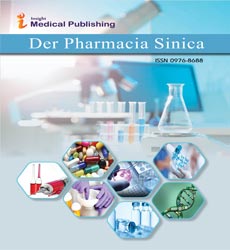ISSN : 0976 - 8688
Der Pharmacia Sinica
Pharmaceutical analysis: Methods used in Testing:
Khairi Mustafa Salem*
College of Pharmacy, Al Ain University of Science and Technology, Al Ain, UAE
- *Corresponding Author:
- Khairi Mustafa Salem
College of Pharmacy, Al Ain University of Science and Technology, Al Ain, UAE
E-mail: salem.mustaf@ac.s
Received Date: November 02, 2021; Accepted Date: November 08, 2021; Published Date:November 13, 2021
Citation: Salem KM (2021) Pharmaceutical Analysis: Methods used in Testing. Der Pharmacia Sinica, Vol.12 No. 6: 20.
Pharmaceutical analysis is a branch of practical chemistry that includes a series of procedures used to identify, determine, quantify, purify, separate components of a solution or mixture, or determine the structure of a compound. The substance can be a single compound or a mixture of compounds and can be in any dosage form. Animals, plants, microorganisms, minerals and various synthetic products are used as medicines. The sample to be analyzed is called analysis and can be classified into macro (0.1 g or more), semi-micro (0.01 g to 0.1 g), micro (0.001 g to 0.01 g), and sub-micro (0.0001) based on the sample size to 0.001 g), ultramicro (less than 104 g), microanalysis (100-100,000 ppm). Semi-micro analysis is widespread in all of them.
TYPES
There are main two types of chemical analysis.
1. Qualitative (identification)
2. Quantitative (estimation)
1. A qualitative analysis is performed to determine the composition of natural / synthetic substances. These tests are performed to show if a substance or compound is present in the sample. Various qualitative tests include gas generation detection, precipitation; limit testing, color change reactions, melting point and boiling point tests.
2. Quantitative analysis techniques are primarily used to quantify each compound or substance in a sample.
These techniques are based in
(a) Quantify the appropriate chemical reaction and measure the amount of reagents added to complete the reaction or the amount of reaction product obtained.
(b) Characteristic movement of a substance through a defined medium under controlled conditions.
(c) Electrical measurement,
(d) Measurement of some spectroscopic properties of the compound.
Various types of Qualitative analysis
1. Chemical methods
a) Titrimetric or volumetric method
The substance to be measured is used as a standard solution and reacted with an appropriate reagent, and the amount of solution required to complete the reaction is measured. The volumetric method requires simple, equipment-related equipment and is highly accurate.
Various types of titrimetric methods are
i) Acid-base titrations (neutralization reactions)
ii) Complexometric titrations
iii) Precipitation titrations
iv) Oxidation reduction titrations
v) Non aqueous titrations
b) Gravimetric methods
In gravimetric analysis, the substance to be measured is converted into an insoluble precipitate in its purest form, which is collected and weighed. It's a time-consuming process. In electroweighting, the sample is electrolyzed and the electrodes are weighed after drying. Thermogravimetric analysis (TG) records changes in weight, differential thermal analysis (DTA) records the temperature difference between the test material and the inert reference material, and differential scanning calorimetry (DSC) produces a zero temperature difference. Record the energy required to do the test and reference substances.
c) Gasometric analysis
Gas measurement measures the amount of gas generated or absorbed by a chemical reaction. Gases analyzed by gas measurement include CO2, N2O, cyclopropane, amyl nitrite, ethylene, N2 and helium.
2. Electrical methods
Electroanalytical methods involve measuring current, voltage, or resistance in relation to the concentration of some species in solution.
Electrical methods of analysis include:
(a)Potentiometry
(b)Conductometry
(c)Polarography
(d)Voltametry
(e)Amperometry
3. Instrumental methods of analysis
The instrumental method measures some physical properties of a compound or substance. These methods are used to measure low or trace levels of elements in a sample. The instrumental method is preferred because of its selectivity, speed, accuracy, and ease of analysis. Changes in system characteristics are recorded by measuring absorption, specific rotation, refractive index, transfer difference, charge-to-mass ratio, and so on. Spectroscopy relies on measuring the amount of radiant energy at a particular wavelength obtained from a sample. Methods involving radiation absorption include ultraviolet, visible, infrared, atomic absorption, and nuclear magnetic resonance spectroscopy. The emission method involves heating or electrically processing the sample so that the atom is excited and emits its energy and intensity. Energy is measured. Emission methods include emission spectroscopy, frame photometer, and fluorescence. Chromatography and electrophoresis are methods of separating a mixture of compounds, but they are also used to identify compounds in the mixture. Various chromatography techniques include GC, HPLC, TLC, HPTLC, and PC. Mass spectrometry uses a high vacuum to evaporate the material and irradiate the vapor with a high-energy electron beam. Vapor molecules are fragmented to produce ions of various sizes. These ions are distinguished by being accelerated by an electric field and then deflected by a magnetic field. Each type of ion gives a peak to the mass spectrum.
4. Biological and microbiological methods
Biological methods are used when the effectiveness of a drug or its derivative cannot be adequately determined by physical or chemical methods. They are called bioassays. Microbiological methods are used to monitor the effectiveness of antibiotics or antibacterial agents. The antibacterial assay compares the inhibition of bacterial growth in the sample with the inhibition of standard antibiotics. These methods include the beaker plate method and turbidimetry analysis.
Open Access Journals
- Aquaculture & Veterinary Science
- Chemistry & Chemical Sciences
- Clinical Sciences
- Engineering
- General Science
- Genetics & Molecular Biology
- Health Care & Nursing
- Immunology & Microbiology
- Materials Science
- Mathematics & Physics
- Medical Sciences
- Neurology & Psychiatry
- Oncology & Cancer Science
- Pharmaceutical Sciences
